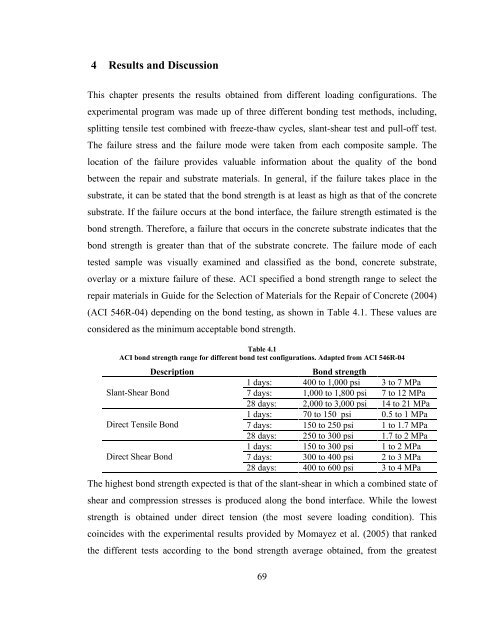compatibility of ultra high performance concrete as repair material
compatibility of ultra high performance concrete as repair material
compatibility of ultra high performance concrete as repair material
Create successful ePaper yourself
Turn your PDF publications into a flip-book with our unique Google optimized e-Paper software.
4 Results and DiscussionThis chapter presents the results obtained from different loading configurations. Theexperimental program w<strong>as</strong> made up <strong>of</strong> three different bonding test methods, including,splitting tensile test combined with freeze-thaw cycles, slant-shear test and pull-<strong>of</strong>f test.The failure stress and the failure mode were taken from each composite sample. Thelocation <strong>of</strong> the failure provides valuable information about the quality <strong>of</strong> the bondbetween the <strong>repair</strong> and substrate <strong>material</strong>s. In general, if the failure takes place in thesubstrate, it can be stated that the bond strength is at le<strong>as</strong>t <strong>as</strong> <strong>high</strong> <strong>as</strong> that <strong>of</strong> the <strong>concrete</strong>substrate. If the failure occurs at the bond interface, the failure strength estimated is thebond strength. Therefore, a failure that occurs in the <strong>concrete</strong> substrate indicates that thebond strength is greater than that <strong>of</strong> the substrate <strong>concrete</strong>. The failure mode <strong>of</strong> eachtested sample w<strong>as</strong> visually examined and cl<strong>as</strong>sified <strong>as</strong> the bond, <strong>concrete</strong> substrate,overlay or a mixture failure <strong>of</strong> these. ACI specified a bond strength range to select the<strong>repair</strong> <strong>material</strong>s in Guide for the Selection <strong>of</strong> Materials for the Repair <strong>of</strong> Concrete (2004)(ACI 546R-04) depending on the bond testing, <strong>as</strong> shown in Table 4.1. These values areconsidered <strong>as</strong> the minimum acceptable bond strength.Table 4.1ACI bond strength range for different bond test configurations. Adapted from ACI 546R-04DescriptionBond strength1 days: 400 to 1,000 psi 3 to 7 MPaSlant-Shear Bond7 days: 1,000 to 1,800 psi 7 to 12 MPa28 days: 2,000 to 3,000 psi 14 to 21 MPa1 days: 70 to 150 psi 0.5 to 1 MPaDirect Tensile Bond7 days: 150 to 250 psi 1 to 1.7 MPa28 days: 250 to 300 psi 1.7 to 2 MPa1 days: 150 to 300 psi 1 to 2 MPaDirect Shear Bond7 days: 300 to 400 psi 2 to 3 MPa28 days: 400 to 600 psi 3 to 4 MPaThe <strong>high</strong>est bond strength expected is that <strong>of</strong> the slant-shear in which a combined state <strong>of</strong>shear and compression stresses is produced along the bond interface. While the loweststrength is obtained under direct tension (the most severe loading condition). Thiscoincides with the experimental results provided by Momayez et al. (2005) that rankedthe different tests according to the bond strength average obtained, from the greatest69
















